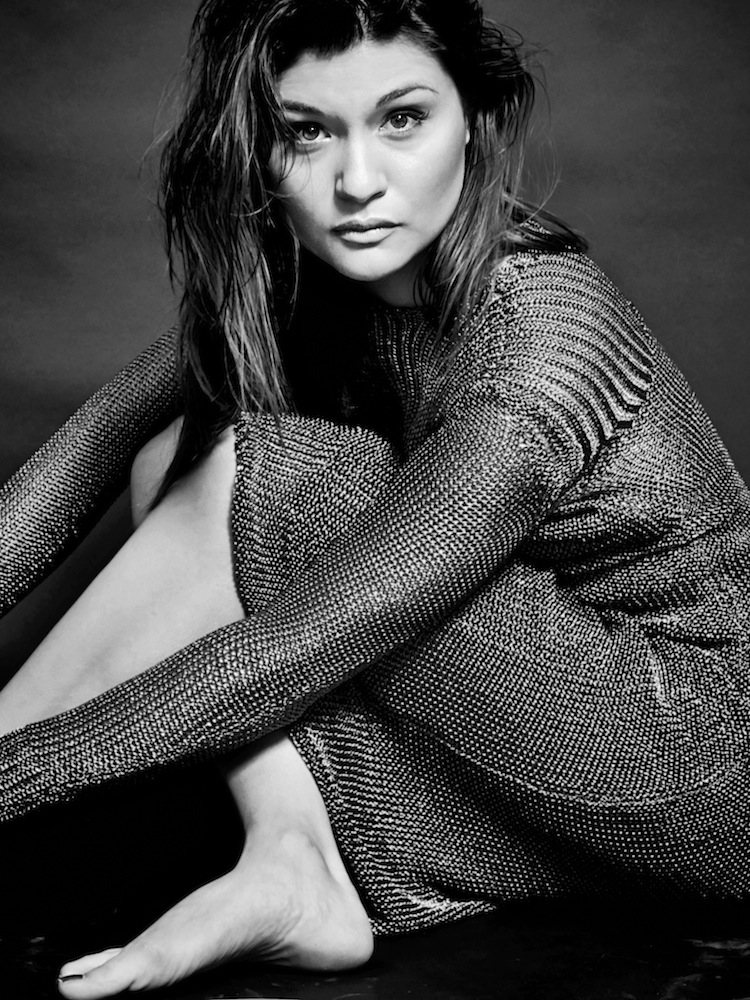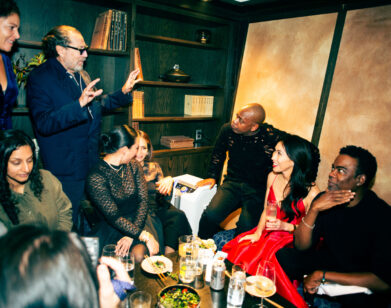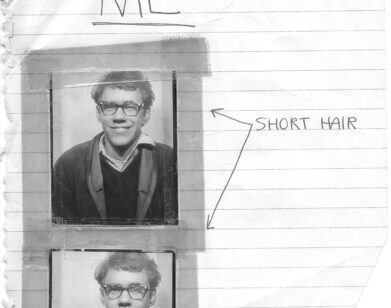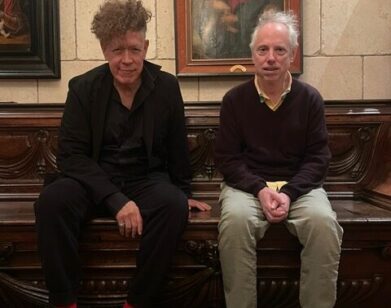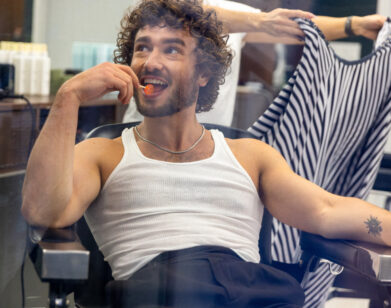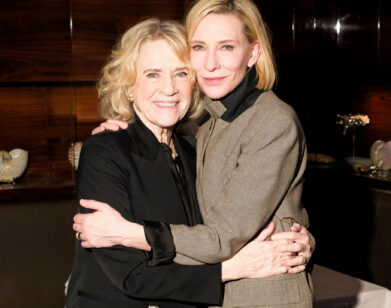More than Mrs. Hamilton
PHOTO: HAO ZENG. STYLING: SAVANNAH WHITE. HAIR AND MAKEUP: MAHFUD IBRAHIM FOR EXCLUSIVE ARTISTS MANAGEMENT USING CHARLOTTE TILBURY AND ORIBE HAIR CARE.
Historians rarely focus on Eliza Schuyler Hamilton, the wife of founding father Alexander Hamilton. There are no accounts of how she felt about her husband’s very public sex scandal, the debt he accumulated, or the death of her eldest son in a duel defending his father’s honor. Her place in history is relegated to her role as a wife: helping Hamilton’s political career with her family money and connections (her father was a senator in New York), contributing to his papers, and campaigning to preserve his memory after his death. It’s not unexpected—she died at the age of 97 in 1854—but that doesn’t make it fair. Schuyler Hamilton was an interesting woman in her own right. She outlived her husband by 50 years, devoted herself to philanthropic work, and helped to establish the first New York private orphanage in 1806.
“I think that’s what Hamilton does,” explains actress Phillipa Soo, who plays Eliza in Lin-Manuel Miranda’s phenomenal (and phenomenon) musical. “It highlights all of the amazing things about our country, but it also highlights the flaws, a huge one being that women were not part of recorded history,” she continues. “I think the most powerful thing in the play is the question of who tells your story. For Eliza, she asks, ‘Will they tell my story?’ And we are doing that. But for her in that moment, I wonder would she even fathom that one day her legacy would be brought to the Broadway stage?”
The daughter of a doctor and a dramaturge for a European theater company, Soo grew up in Libertyville, Illinois, and was always involved in the arts. After graduating from Julliard just three years ago, she made her theatrical debut Off-Broadway in Dave Malloy’s musical adaptation of War and Peace, Natasha, Pierre & The Great Comet of 1812. “There was never a day that I was like, ‘Well, I could be a doctor, but I’m going to choose theater.’ I never had that moment, it was just, ‘Yes, I would love to do theater. I don’t see myself doing anything else,'” she recalls.
Hamilton, which ran at The Public Theatre before transferring to Broadway, marks Soo’s Broadway debut. Starring Miranda, Leslie Odom Jr, Renée Elise Goldberry, Daveed Diggs, and Jonathan Groff, the play tells the story of Hamilton and closest to him from his birth to death at the hands of Aaron Burr. There is little spoken dialogue, and the musical numbers span everything from raps to conventional showtunes. It is neither a classic musical nor a hip-hopera; without confining itself to any one genre, it feels completely cohesive.
EMMA BROWN: Can you tell me a little bit about how you became involved in Hamilton?
PHILLIPA SOO: The first time I heard about it was back in 2009, when Lin performed the first rap at the White House. A friend who was a huge Lin-Manuel fan had showed me this video. We were both in school at the time; I went to Julliard. He was like, “Isn’t this amazing?” And I said, “That’s so cool. This guy wrote In the Heights? Oh!” Then cut to four, five years later and [director] Tommy [Kail] calls me and asks me to do a table reading just of Act Two. He said, “You may remember it from the YouTube video of Lin performing at the White House. Now it’s a show!” I had no idea what they’d been doing since I first saw it, [but] I said absolutely because I thought they were an amazing team. He said, “We want you to play Eliza Hamilton.” And I was like, “Okay, great! Wait…who was she?” I joined them in December 2013 for that table reading. It was very simple, just to hear it out loud. Songs hadn’t been written yet.
EMMA BROWN: What was that table reading like? There’s so little spoken dialogue in the show, were you just reading directions?
SOO: We learned the music for a week and then we had a little presentation for [choreographer] Andy [Blankenbuehler], Tommy, [Public Theatre Artistic Director] Oskar Eustis, and a few people at The Public—it was a small group, maybe 10 people watching it. It was really more for Lin to see how it worked—how it carried out loud, what it sounded like—and maybe give him some ideas for finishing it. I joined them again in January of that next year, 2014, and that was the first time the whole show was put together in one full swoop.
BROWN: Did you ever ask them, “What made you think of me?”
SOO: I did. I knew that they had come to see my show Natasha, Pierre & The Great Comet of 1812, which was my New York theatrical debut. That was my first job that I booked out of school. Both Tommy and Lin had spent a lot of time developing work at Ars Nova, which is where this production took place. It was no wonder that those communities came together at that moment, because they had worked there and they had come to see the show there. But both of them were like, “We remembered you from that show and were like, ‘She should play Eliza.'”
BROWN: It’s interesting that they were so decided.
SOO: I think at that point they were just putting together a cast to see who worked and we were all very fortunate that I kept getting to come back and work with them.
BROWN: You mentioned you didn’t know anything about Eliza in the beginning. Did you know anything about Alexander Hamilton? I didn’t even know that he was killed by Aaron Burr.
SOO: That’s the one thing I knew, only because of the “Got Milk” commercial. My parents quoted that all the time. They always thought it was so funny.
BROWN: I saw the remake that the Hamilton cast did.
SOO: Yes, which was brilliant. That made me so happy.
BROWN: Did you send it to your parents?
SOO: I didn’t, but they are so supportive and following the bandwagon that they find things before I do. “Look at this article with you guys in it!” They’ll send me stuff. They’re like my second press team.
BROWN: When you were at Julliard, did you focus on theater? Or was it acting for all mediums?
SOO: The program has really changed a lot, even since I went there. It’s definitely a theatrical-based program, but they go by the motto, “Tools, not rules,” and, “Truth is truth no matter how big or small.” I think that’s why you see a lot of people doing film and theater and television and comedia and mask work and all of these interesting theatrical art forms. It creates a well-rounded artist. I benefitted from that because it wasn’t necessarily a musical theater program, but we had singing class, and I was able to have some singing performance opportunities. We did a student-initiated project of A Little Night Music, which was the first time that all of the divisions—music, dance, drama, opera—came together and put on a piece. It was a black box kind of feel. We had to get costumes that were pieced together. We had our own lighting that we finagled. It was a way for us to understand what went into putting on a production. Now they have a whole project created around it that you can do on your spare time, which is usually just Sundays.
BROWN: Were you always into musical theater?
SOO: I took dance from a very early age, although my first recital I remember refusing to go onstage. I think I was three. It’s funny because that stage was also my high school theater stage. I remember refusing to go on and then feeling really cool because I got to hang out with all the older girls with their point shoes and their Swan Lake costumes backstage—they were basically babysitting me while I was refusing to go onstage. In the end, my teacher was like, “Will you at least go out and bow?” I shook my head. “Well, what if I we did a bow together?” “Oh, okay, that sounds fine.” [laughs] I had my own special bow with my teacher even though I didn’t perform that day and I remember going out there and being like, “Oh, this isn’t so bad.”
BROWN: Do you remember the first play you were able to sit through as a child and really connect with?
SOO: Yeah. My mother took my brother and I to a production of The Tempest, and it was in this very small—it could have been the basement of a church or a black box. The space was vast, but there were maybe 15 seats in the middle. Ariel came out wearing a nude sparkly thong and spike heels, and the muses had these gossamer see-through gowns on. I don’t think my mother realized that there was nudity. I was eight or nine; my brother was 10 or 11. To this day, that play is my favorite Shakespeare play. I’ll never forget how magical that seemed to me, even though if I saw it now, I’d probably be like, “Hmm. This is an…interesting production.” I was totally into it.
BROWN: Did you feel awkward or embarrassed watching something like that with a parent?
SOO: No, I don’t remember thinking, “This is weird.” I think my mother was feelings those feelings for us, but I was just entranced because the play itself is another world. It’s wild and weird and I think I was really drawn to that in contrast to growing up doing a lot of ballet. It was gritty and interesting, and I think that’s when I was like, “Oh, I like the theater.” Dance was awesome, but the theater was wild and crazy.
BROWN: There are a lot of resources for all the men in the show: biographies on Burr, Hamilton etc. What was it like researching Eliza Hamilton? Was there a lot written about her?
SOO: Not really. There are some personal accounts. I probably could have done a lot more digging. I did have a few conversations with Ron [Chernow, author of the biography Alexander Hamilton] and found some short paragraphs: “And Mrs. Schuyler Hamilton came to the party.” But it’s difficult; there really isn’t that much out there. We can assume that she helped Hamilton write some of his papers at one point because the handwriting changes and there are spelling mistakes that he probably wouldn’t have made.
BROWN: You’ve been doing the show for a while—first at The Public and now on Broadway. How do you keep yourself engaged in each performance?
SOO: The question you just asked is the question that I’m asking myself every time we go to perform. Finding ways in, it can be as easy as reading something or filling the well or going to see a show—finding inspiration in your own life on your own time. Or it’s just when you’re in the space and you’re acting with your scene partner, really being present. You start to notice things that you’ve never noticed before, and there are thousands of things that you can pick up on. Because it’s a live show, there are things that are going to be different every day. Just this week, we’ve had a couple of new people come in because of some injuries, and we’re excited for that. I don’t think for a second anyone gets nervous because we know that we’ve built something so strong, and we’re all so present, we can bring anything into the mix and the story still works. It’s a dream work environment really.
BROWN: Is there a moment in the play that you look forward to? Or a moment you dread?
SOO: I love the moment that the Schuyler sisters’ number starts; for me, that’s the launch into the play. It’s one of the hardest songs to sing, as well as the fastest song I have to sing. It goes the highest and the notes are the most sustained. After that moment I think, “Ahhh, I’m in the show.” I usually don’t dread things, but recently it’s been interesting coming to the second act and the emotional journey of the play. There are some days when I’m thinking, “Is it there today?” and looking around and being like, “Oh yeah. This is our story. It’s always there.” It’s a matter of always re-convincing myself that the work that I’ve done lives there and there’s no mustering up any more. We know from our readings that we could do the show standing behind music stands and that still lifts the text, along with all the other stuff that we have now—the movement, the lighting, the sound design, the costumes. That only enhances all of that and builds a stronger ship to sail, so to speak. So I find comfort and confidence in that. Some days there are important people in the audience that I know will have a response to this journey and the story, and so it makes me feel for them what I think or hope that might be feeling. Sometimes the emotion is uncontrollable.
HAMILTON IS CURRENTLY ON AT THE RICHARD ROGERS THEATRE. FOR MORE INFORMATION, VISIT THE PLAY’S WEBSITE.

